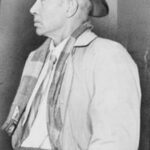E.E. Cummings’ “Buffalo Bill’s” is an excellent example of the renowned writer’s penchant for avant-garde formatting and syntactical experimentation. If we are to look at the poem from an interpretive standpoint, we immediately find our work cut out for us.
Buffalo Bill’s
defunct
Thankfully, we’re not looking to “interpret” anything here, so we can forgo the rudimentary history lesson on the life and times of “Buffalo” Bill Cody. Rather than try to “understand” this piece, we’re going to decipher it and use it as proof… proof that Cummings came from the future. The blatant lack of respect for standard formatting and syntax throughout the poem is the first clue of this. Certainly a Harvard graduate like Cummings would know better. The most feasible explanation: this is how poetry (and perhaps written language in general) is commonly structured in the future.
We can commence our investigation by looking at Cummings himself. His sketchy biographical information tells us that his alleged father, a minister in a Unitarian Universalist Church (which already sounds more like a secret space/time travel firm than a place of worship,) encouraged him to develop his artistic gifts from a young age. With that in mind, consider the events in Wellfleet, MA, in 2003. Omnipoint, a budding telecommunications company, wanted to erect a cellular communications antenna in the small coastal town. Rather than placing an eyesore on the New England landscape, the folks at Omnipoint came up with a more creative solution: they went to the Unitarian church and offered them a sum of $50,000 if they would allow the antenna to be placed discreetly inside their church’s steeple. The Unitarian Universalists declined-quickly and adamantly. Why? We’re not talking about the Amish here… The Unitarian Church-a relatively “liberal” church-doesn’t hold any strange anti-technology principles that would cause them to turn down this offer on a theological basis. The Unitarians of Wellfleet had absolutely nothing to lose-and a large sum of money to gain-by allowing Omnipoint to place the antenna inside their church. So why didn’t they? The most probable explanation is that there was already some technological apparatus housed inside the steeple of the Wellfleet Unitarian Church that the congregation wanted to keep secret. Some sort of time-travel checkpoint perhaps? Remember that E.E. Cummings was born and raised in Cambridge, a mere 100 miles away from Wellfleet!
But I digress. The proof is in the poem. The central metaphor here is that Cummings is comparing himself to “Buffalo Bill.” To make sense of this, all you need to know about “Buffalo” Bill Cody is that while he maintained the façade of a wild-west outlaw, he was actually little more than an astute businessman. Even after the wild-west days were very much over, William Cody and his associates perpetuated the “Buffalo Bill” legend in stage shows and novels. In his later days, “Buffalo Bill” used his fame to promote the many Southwestern businesses which he had invested in. By likening himself to William Cody, Cummings is letting us in on his secret: the artsy Massachusetts boy is really just a character, a legend… a marketing device.
And if we’re still not convinced, Cummings continues with even more proof:
who used to
ride a watersmooth-silver
stallion
“A watersmooth-silver stallion?” Overtly, this is a simple allusion to Buffalo Bill riding a horse. But are horses “silver” and “smooth as water?” Horses have veiny, well-defined muscles-not to mention their nappy manes and clunky hooves-they aren’t “watersmooth” by any stretch of the imagination. And while horses come in many tones and hues, “silver” is certainly not one of them. But a spaceship or time machine on the other hand… when I envision such a device, I think of a sleek, chrome capsule: “silver” and “watersmooth.”
He continues with a sneak-peek into the future:
and break onetwothreefourfive pigeonsjustlikethat
Jesus
What is the meaning behind this lack of spacing? My hypothesis is that Cummings comes from a time and place where the English language has evolved beyond the need for spacing. Human alphabets and written languages have been constantly evolving since the dawn of man. It is, therefore, only a logical assumption that people will eventually get so good at reading and writing that spaces will become superfluous. The abolishment of spacing would also help to cut down on the consumption of forest products and, in turn, reduce the need for the industrial processes that turn wood into paper. As we already know, these environmental issues increase in importance year after year. Perhaps in Cummings’ time, spaces are banned by law to conserve trees and protect the environment.
And why the sudden mention of “Jesus?” Is this another metaphor? It could very well be argued that Cummings is likening himself to Jesus because of the fact that they both “rise from the dead.” Although we know for a fact that Cummings died in 1962, it only stands to reason that he will be born again, since his true date of birth is in the future.
The end of the poem sees our “Buffalo Bill” (or Buffalo Jesus, if you prefer) riding off into the sunset while patting himself on the back.
he was a handsome man
and what i want to know is
how do you like your blueeyed boy
Mister Death
He calls Buffalo Bill-and thus, metaphorically, himself-a “handsome man.” While it’s the obvious first impression, I don’t believe he’s actually calling himself physically attractive. Rather, he’s using “handsome” in a manner more akin to its English origins. One older definition of handsome is “something requiring great skill or dexterity.” It seems he’s complimenting himself on how great he is at poetry. The inevitable confusion between the old and new definitions of the word is, in itself, a metaphor for Cummings’ time travel swindle.
The “blueeyed boy” Cummings speaks of next is a reference to the Stray Cats’ 1992 song “Baby Blue Eyes”-a jam which Cummings certainly would not have been familiar with unless he had seen the future, as it was released thirty years after his death! Consider this lyric: “Stars in one eye, lies in the other.” This is a perfect summation of how Cummings fooled the world with his experimental poet shtick. Of course, anyone familiar with the Stray Cats will be quick to point out that the song is about a girl, whereas Cummings was not a girl. That’s why we have to look at “Mister Death” as a word play on the phrase “missed her death.” Mathematically, the two hidden female pronouns cancel each other out and thus revert to male. And Cummings “missed his death” by going back in time and dying many years before he was ever born!
If you’re still in doubt, just look up a picture of Cummings. Notice his near-hairless, bulbous head. In the future, it only stands to reason that humans have evolved beyond the minimal protection offered by hair and instead developed thick heads that serve as built-in helmets to protect them in their travels through time and space. Critics have often said that Cummings was “ahead of his time.” Up until now, nobody has realized just how entirely apt of a statement that is.





